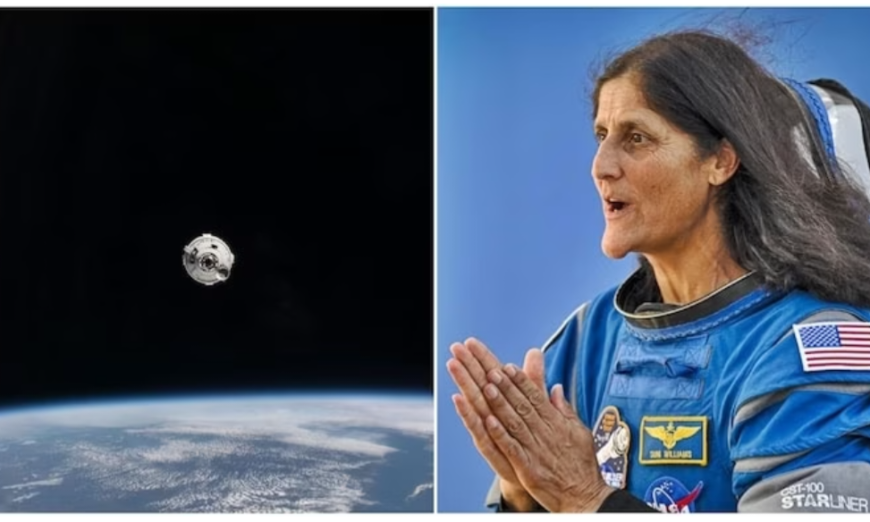The incident occurred when Nasa was informed of a satellite break-up at an altitude near the station. The emergency order was issued as space debris threatened the orbiting laboratory on Wednesday. (Photo by NASA.)
In a tense moment aboard the International Space Station (ISS), Nasa astronauts Sunita Williams and Butch Wilmore were forced to take emergency shelter in Boeing’s Starliner spacecraft and other return vehicles.
The emergency order was issued as space debris threatened the orbiting laboratory on Wednesday.
As a standard precautionary measure, Mission Control instructed all crew members to seek shelter in their respective spacecraft. Williams and Wilmore, who have been aboard the ISS since June 5, took refuge in the Starliner capsule.
For approximately an hour, Mission Control closely monitored the path of the debris while the astronauts remained in their protective shelters. After determining that the immediate threat had passed, the crew was given the all-clear to exit their spacecraft and resume normal operations on the station.
This event highlights the ongoing challenge of space debris and the importance of safety protocols in orbital operations. It also demonstrated the Starliner’s capability to serve as a potential lifeboat in emergency situations, a crucial function for any crew vehicle docked at the ISS.
The incident comes amid an already extended stay for Williams and Wilmore, whose return to Earth has been delayed due to technical issues with the Starliner spacecraft.
Originally scheduled for an 8-day mission, the astronauts have now been in space for over three weeks as Nasa and Boeing work to resolve helium leaks and thruster problems that have plagued the capsule.
Despite these challenges, Nasa has maintained that the Starliner is capable of safely returning the astronauts to Earth if absolutely necessary. This recent shelter-in-place event further underscores the spacecraft’s vital role in ensuring crew safety.
As space activities continue to increase, the management of orbital debris remains a critical concern for space agencies worldwide.
*
Russian satellite breaks into 100 pieces near ISS where Sunita Williams is stuck in space.
The U.S. Space Command confirmed the incident, reporting that the explosion generated nearly 100 trackable pieces of space debris.
India-born astronaut Sunita Williams’ highly anticipated return to Earth from the International Space Station (ISS) faces indefinite delays following a concerning incident involving a defunct Russian satellite.
The satellite, RESURS-P1 (#39186), disintegrated into hundreds of pieces of debris in low-Earth orbit on Wednesday, posing a significant navigational hazard near the ISS. While there’s no immediate threat to the astronauts on board, the incident forced them to take shelter for an hour and has cast uncertainty over future missions, including Williams’ return.
“Due to the low orbit of this debris cloud, we estimate it’ll be weeks to months before the hazard has passed,” stated LeoLabs, a space tracking company, highlighting the long-term impact of the event.
The U.S. Space Command confirmed the incident, reporting that the explosion generated nearly 100 trackable pieces of space debris.
Uncertainty Looms over Boeing Starliner Mission
Adding to the complexity, Williams’ return flight aboard Boeing’s Starliner spacecraft, originally slated for a few days, is now facing significant delays, potentially stretching to months.
“Projected to last only days, the first crewed test flight of Boeing’s Starliner spacecraft with two astronauts onboard is in limbo with no exact return to Earth announced,” confirmed reports.
Williams, alongside NASA astronaut Butch Wilmore, boarded the Starliner capsule on June 6 for its first crewed test mission. However, the recent events have thrown their mission timeline into disarray.
NASA’s Commercial Crew Program manager, Steve Stich, revealed that the agency is considering extending Starliner’s mission from 45 days to 90 days.
“We’re just looking at the timeline to execute (the test in New Mexico) and then review the data,” Stich explained during a briefing, emphasising the lack of urgency in their return. “And that’s what’s really the long pole, I would say, determining a landing date. We’re not in a rush to come home.”
While the delay is undoubtedly disappointing for Williams and her team, ensuring the astronauts’ safety during their descent through the debris field remains paramount. NASA is diligently monitoring the situation and will determine a new return date once the risk from the space debris has sufficiently subsided

